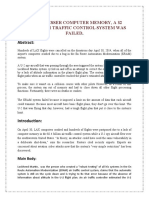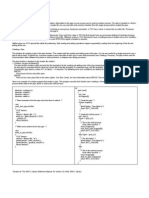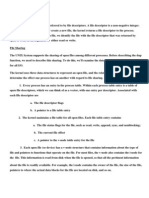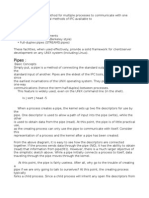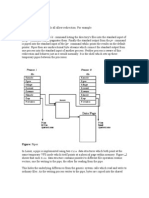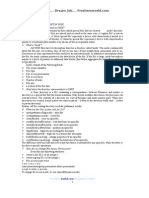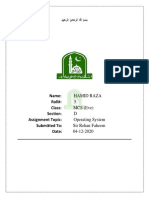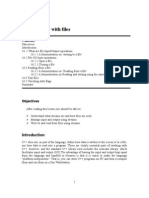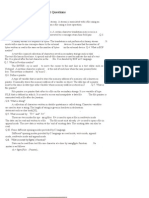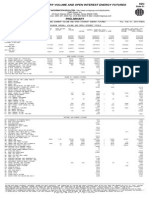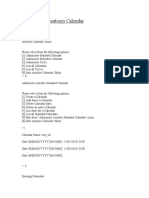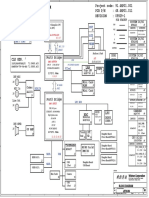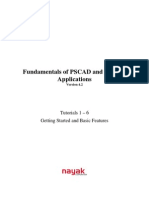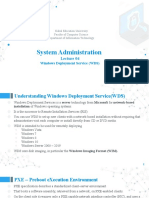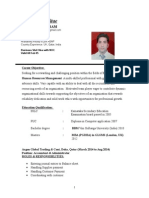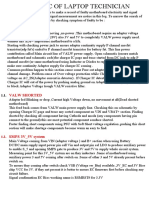Interprocess Communication
Interprocess Communication
Uploaded by
avadcsCopyright:
Available Formats
Interprocess Communication
Interprocess Communication
Uploaded by
avadcsOriginal Description:
Copyright
Available Formats
Share this document
Did you find this document useful?
Is this content inappropriate?
Copyright:
Available Formats
Interprocess Communication
Interprocess Communication
Uploaded by
avadcsCopyright:
Available Formats
Interprocess Communication
1. What is a pipe? a. Pipe is a IPC mechanism using which processes can communicate. 2. A pipe is a one-way flow of data between processes. 3. All data written to pipe is routed by the kernel to another process 4. Pipes may be considered open files that have no corresponding image in the filesystems 5. How a pipe is created? a. Using pipe() 6. What is pipe operator in unix shell? a. pipe operator in unix shell is | 7. How a pipe works? a. pipe() creates a pipe and it returns a pair of file descriptors i. Process may then pass these descriptors to its descendants through fork() ii. The processes can read from the pipe by using read() system call with the first file descriptor iii. The processes can write to the pipe by using write() system call with the second file descriptor 8. How pipe is implemented in Linux? a. In linux popen() and pclose() are used to create and close pipe. These functions are included in c library i. popen() receives two parameters filename pathname of an executable file and type string specifying the direction of data transfer 9. How popen() works in linux? a. Following operations are done by popen() i. Creates a new pipe using popen() system call ii. Forks a new process, which in turn executes the following operations If type is r, it duplicates the file descriptor associated with the pipes write channel as a file descriptor 1 (standard output); otherwise if type is w, it duplicates the file descriptor associated with pipes read channel as file descriptor 0 (Standard input) Closes the file descriptors returned by pipe() Invokes the execve() system call to execute the program specified by file name. iii. If type is r, it closes the file descriptor associated with pipes write channel; otherwise, if type is w, it closes the file descriptor associated with pipes read channel. iv. Returns the address of the FILE the file pointer that refers to whichever file descriptor for the pipe is still open b. After the popen() invocation, parent and child can exchange information through the pipe
10.
11. 12. 13. 14.
i. The parent can read (if type is r) or write (if type is w) data by using the FILE pointer returned by the function. ii. The data is written to the standard output or read from the standard input, respectively, by the program executed by child process. What are the disadvantages of Pipes? a. Pipes have no names. b. It works only between processes that have a parent process in common. POSIX defines only half duplex pipes What is a FIFO? a. FIFO is a named pipe. FIFOs are half duplex. How FIFO is created? a. FIFO is created using the mkfifo function int mkfifo (const char *pathname, mode_t mode); Arguments of mkfifo are as below path name is name of pipe mode argument specifies the file permission bits ii. The mkfifo function implies O_CREAT | O_EXCL iii. Once FIFO is created, it must be opened for reading or writing Open() or fopen() can be used A FIFO must be opened as read-only or write-only A write to a FIFO always appends the data, and a read from FIFO always returns what is at the beginning of the FIFO. What are the differences between Pipe and FIFO? a. Pipe is nameless and works with process that have a parent in common b. FIFO are name and works with unrelated processes c. To create and open a pipe requires one call to pipe. To create FIFO mkfifo is required and to open it, a call to open is required. d. A pipe automatically disappears on its last close. A FIFOs name is deleted from the file system only by calling unlink() Data in pipes and FIFOs is byte stream i.
15. 16. 17.
18.
You might also like
- Lab 07Document4 pagesLab 07majidshafiNo ratings yet
- (Book Notes) Inspired by Marty CaganDocument13 pages(Book Notes) Inspired by Marty CaganMarcos Ciarrocchi100% (6)
- A318/A319/A320/A321: Service BulletinDocument119 pagesA318/A319/A320/A321: Service BulletinPradeep K sNo ratings yet
- Due To Lesser Computer Memory, A $2 Billion Air Traffic Control System Was FailedDocument3 pagesDue To Lesser Computer Memory, A $2 Billion Air Traffic Control System Was FailedSidra TulmuntahaNo ratings yet
- Eetop - CN ADC LayoutDocument199 pagesEetop - CN ADC LayoutVishnuGundaNo ratings yet
- Gujarat University: Bachelor of Architecture Outline For All Semesters (Batch 2015 Onwards)Document12 pagesGujarat University: Bachelor of Architecture Outline For All Semesters (Batch 2015 Onwards)KrutiGDesaiNo ratings yet
- IB RulesDocument29 pagesIB RulesAbhishek ChauhanNo ratings yet
- CS312 Lec 13Document13 pagesCS312 Lec 13syedbasimmehmood1No ratings yet
- LP Unit4Document43 pagesLP Unit4Amrutha TarigopulaNo ratings yet
- Unit 8: Inter Process CommunicationDocument60 pagesUnit 8: Inter Process CommunicationSandeep KhandekarNo ratings yet
- Interprocess Communication Mechanisms: UNIT-3 Cooperating ProcessesDocument24 pagesInterprocess Communication Mechanisms: UNIT-3 Cooperating ProcessesChandra Teja PuramNo ratings yet
- NplabDocument78 pagesNplabachutha79583050% (2)
- Interprocess Communication Pipes Fifos Message Queues - SemaphoresDocument41 pagesInterprocess Communication Pipes Fifos Message Queues - SemaphoresUday KiranNo ratings yet
- Inter Process CommunicationDocument17 pagesInter Process CommunicationArun KumarNo ratings yet
- PipesDocument1 pagePipesLuis OrduzNo ratings yet
- Unit-Ii FILES (17 Marks) : 1. What Is File Explain How To Open and Close A FileDocument38 pagesUnit-Ii FILES (17 Marks) : 1. What Is File Explain How To Open and Close A FileJack TwatNo ratings yet
- UnixDocument8 pagesUnixKannan RaviNo ratings yet
- Ipc (Pipe and Message Queue)Document17 pagesIpc (Pipe and Message Queue)Dipayan BoseNo ratings yet
- UNIX Concepts: 1. How Are Devices Represented in UNIX?Document16 pagesUNIX Concepts: 1. How Are Devices Represented in UNIX?Pradeep TiwariNo ratings yet
- Unit 8 - File HandlingDocument16 pagesUnit 8 - File HandlingAnurag GoelNo ratings yet
- Lab 9 PDFDocument3 pagesLab 9 PDFMuddassir AhmedNo ratings yet
- Files: Closing A File: A File Must Be Closed As Soon As All Operations Have Been ClosedDocument12 pagesFiles: Closing A File: A File Must Be Closed As Soon As All Operations Have Been ClosedJagannadha VarmaNo ratings yet
- UNIX Concepts: 1. How Are Devices Represented in UNIX?Document15 pagesUNIX Concepts: 1. How Are Devices Represented in UNIX?api-3764166No ratings yet
- Unit 4: Dr. Mohammad Sultan AlamDocument70 pagesUnit 4: Dr. Mohammad Sultan AlamAbhinav JainNo ratings yet
- Unit 6_Interprocess Communication Unit 6Document32 pagesUnit 6_Interprocess Communication Unit 6kartavya9878No ratings yet
- BCA Paper-V Unit-10Document15 pagesBCA Paper-V Unit-10nagaNo ratings yet
- PipesDocument2 pagesPipesSia UpretiNo ratings yet
- Unix Lab ManualDocument22 pagesUnix Lab ManualKan15No ratings yet
- Pipes and FifoDocument8 pagesPipes and FifoAckermanNo ratings yet
- Unit 6 - Interprocess CommunicationDocument32 pagesUnit 6 - Interprocess CommunicationNishant NalawadeNo ratings yet
- Operating Systems Design 19CS2106R Session-10 Lecture Notes File System CallsDocument12 pagesOperating Systems Design 19CS2106R Session-10 Lecture Notes File System Callssreeram chowdharyNo ratings yet
- Unit VDocument29 pagesUnit VDark soulNo ratings yet
- Chapter 14: Interprocess Communication: CMPS 105: Systems Programming Prof. Scott Brandt T TH 2-3:45 Soc Sci 2, Rm. 167Document35 pagesChapter 14: Interprocess Communication: CMPS 105: Systems Programming Prof. Scott Brandt T TH 2-3:45 Soc Sci 2, Rm. 167Halder SubhasNo ratings yet
- UNIT-5 File Management in C: There Are Two Types of Files in C LanguageDocument12 pagesUNIT-5 File Management in C: There Are Two Types of Files in C LanguageparmeshNo ratings yet
- Module5 Chap1Document14 pagesModule5 Chap1Sonia DeviNo ratings yet
- Lab 6 PDFDocument3 pagesLab 6 PDFMuddassir AhmedNo ratings yet
- Unit-5(Part-3)File Handling in CDocument18 pagesUnit-5(Part-3)File Handling in Crameshjaiswal365No ratings yet
- Unit 5 Files For CivilDocument17 pagesUnit 5 Files For CivilPraneeth KumarNo ratings yet
- C ++ Module 4Document5 pagesC ++ Module 4Chinmayee AravindNo ratings yet
- LP Unit4Document38 pagesLP Unit4yashwanth saiNo ratings yet
- UNIX Concepts: 1. How Are Devices Represented in UNIX?Document15 pagesUNIX Concepts: 1. How Are Devices Represented in UNIX?Enayatali_Agha_2085No ratings yet
- Unix Q&A'sDocument11 pagesUnix Q&A'sapi-3834148No ratings yet
- Programming in C: Standard File PointersDocument7 pagesProgramming in C: Standard File PointersAbdur RazaqNo ratings yet
- Homework 8: Swing Components in Java: Object Oriented Programming - LecDocument16 pagesHomework 8: Swing Components in Java: Object Oriented Programming - LecEricka Michelle LabajoNo ratings yet
- UNIT 5 PC NOTESDocument30 pagesUNIT 5 PC NOTESmathibm92No ratings yet
- Exercise 6a. Inter Process Communication - Pipe DateDocument5 pagesExercise 6a. Inter Process Communication - Pipe DateALKESH KUMRAWATNo ratings yet
- Fopen, Fclose, Gets, Fputs Functions in CDocument7 pagesFopen, Fclose, Gets, Fputs Functions in CUma MaheshNo ratings yet
- ospp-chap05-part3Document9 pagesospp-chap05-part3asjeevannavarNo ratings yet
- CH - 5 Files (C++)Document20 pagesCH - 5 Files (C++)solomondagi7No ratings yet
- Data File Handling - 093933Document4 pagesData File Handling - 093933gogoiabinash300No ratings yet
- Name: Roll#: 5 Class: MCS (Eve) Section: D Submitted To: Sir Rehan FaheemDocument5 pagesName: Roll#: 5 Class: MCS (Eve) Section: D Submitted To: Sir Rehan FaheemHamid RazaNo ratings yet
- All UNIX Interview QuestionsDocument14 pagesAll UNIX Interview QuestionsPrem KumarNo ratings yet
- Standard I/O Library: Streams and FilesDocument30 pagesStandard I/O Library: Streams and Filesjhon bookNo ratings yet
- File HandlingDocument39 pagesFile Handlingranjan_prashant52No ratings yet
- How Are Devices Represented in UNIX?Document17 pagesHow Are Devices Represented in UNIX?api-26345612No ratings yet
- Inter Process CommunicationDocument52 pagesInter Process Communicationsougata88No ratings yet
- Session16 DraftDocument8 pagesSession16 Draftapi-3845857No ratings yet
- Tut 4Document38 pagesTut 4f20220057No ratings yet
- Short QuestionsDocument2 pagesShort Questionsa2zniceNo ratings yet
- Simple ShellDocument8 pagesSimple ShellBrian MutembeiNo ratings yet
- Chapter 2 and 3 - File ManagementDocument16 pagesChapter 2 and 3 - File ManagementNohaNo ratings yet
- Mastering Python Programming: A Comprehensive Guide: The IT CollectionFrom EverandMastering Python Programming: A Comprehensive Guide: The IT CollectionRating: 5 out of 5 stars5/5 (1)
- Hacks, Leaks, and Revelations: The Art of Analyzing Hacked and Leaked DataFrom EverandHacks, Leaks, and Revelations: The Art of Analyzing Hacked and Leaked DataNo ratings yet
- Exchange Summary Volume and Open Interest Equity Index FuturesDocument2 pagesExchange Summary Volume and Open Interest Equity Index FuturesavadcsNo ratings yet
- Exchange Summary Volume and Open Interest Equity Index FuturesDocument2 pagesExchange Summary Volume and Open Interest Equity Index FuturesavadcsNo ratings yet
- Exchange Summary Volume and Open Interest Equity Index FuturesDocument2 pagesExchange Summary Volume and Open Interest Equity Index FuturesavadcsNo ratings yet
- Exchange Summary Volume and Open Interest Equity Index FuturesDocument2 pagesExchange Summary Volume and Open Interest Equity Index FuturesavadcsNo ratings yet
- Exchange Summary Volume and Open Interest Equity Index FuturesDocument2 pagesExchange Summary Volume and Open Interest Equity Index FuturesavadcsNo ratings yet
- Exchange Summary Volume and Open Interest Equity Index FuturesDocument2 pagesExchange Summary Volume and Open Interest Equity Index FuturesavadcsNo ratings yet
- Exchange Summary Volume and Open Interest Equity Index FuturesDocument2 pagesExchange Summary Volume and Open Interest Equity Index FuturesavadcsNo ratings yet
- Exchange Summary Volume and Open Interest Equity Index FuturesDocument2 pagesExchange Summary Volume and Open Interest Equity Index FuturesavadcsNo ratings yet
- Exchange Summary Volume and Open Interest Equity Index FuturesDocument2 pagesExchange Summary Volume and Open Interest Equity Index FuturesavadcsNo ratings yet
- Exchange Summary Volume and Open Interest Equity Index FuturesDocument2 pagesExchange Summary Volume and Open Interest Equity Index FuturesavadcsNo ratings yet
- Exchange Summary Volume and Open Interest Equity Index FuturesDocument2 pagesExchange Summary Volume and Open Interest Equity Index FuturesavadcsNo ratings yet
- Exchange Summary Volume and Open Interest Energy Futures: PreliminaryDocument9 pagesExchange Summary Volume and Open Interest Energy Futures: PreliminaryavadcsNo ratings yet
- The Project LifecycleDocument7 pagesThe Project LifecycleShepherd NhangaNo ratings yet
- Strategic Asset Management Plan 2016-2020 PDFDocument64 pagesStrategic Asset Management Plan 2016-2020 PDFghoyarbide100% (1)
- CUDA Binary UtilitiesDocument36 pagesCUDA Binary UtilitiesavpNo ratings yet
- Whitepaper - 2021: Artificial IntelligenceDocument5 pagesWhitepaper - 2021: Artificial IntelligencemidoxxNo ratings yet
- How To Create Autosys CalendarDocument2 pagesHow To Create Autosys Calendarpk_aniNo ratings yet
- John Ferreira ResumeDocument2 pagesJohn Ferreira Resumeapi-476965801No ratings yet
- Acer Aspire 7551 - 7551G Wistron JE70-DN, SJV71-DN, HM72-DN RevSB SchematicDocument63 pagesAcer Aspire 7551 - 7551G Wistron JE70-DN, SJV71-DN, HM72-DN RevSB SchematicBuen DiaNo ratings yet
- MDM Warranty Periode 02042024Document69 pagesMDM Warranty Periode 02042024Samuel Kurnia PutraNo ratings yet
- Lecture-2 - Architecture of Distributed SystemsDocument35 pagesLecture-2 - Architecture of Distributed SystemsTahira AnjumNo ratings yet
- Visvesvaraya Technological University: Jnana Sangama, Belagavi-590018, Karnataka, IndiaDocument22 pagesVisvesvaraya Technological University: Jnana Sangama, Belagavi-590018, Karnataka, IndiaPooja koreNo ratings yet
- TrueType, PostScript Type 1, & OpenType: What's The Difference?Document10 pagesTrueType, PostScript Type 1, & OpenType: What's The Difference?terminatory808No ratings yet
- Manager's Guide To Competitive Marketing Strategies .13Document15 pagesManager's Guide To Competitive Marketing Strategies .13Ameya KambleNo ratings yet
- Workbench Users GuideDocument348 pagesWorkbench Users GuideLuis Humberto Martinez Palmeth100% (1)
- PSCAD TutorialDocument42 pagesPSCAD Tutorialchenukap100% (1)
- Lecture 04 - WDSDocument5 pagesLecture 04 - WDSelhamNo ratings yet
- Sam Kolder Keyboard ShortcutsDocument3 pagesSam Kolder Keyboard Shortcutsmdrayan68No ratings yet
- Institut Perguruan Ilmu Khas: (Basic Mathematic)Document18 pagesInstitut Perguruan Ilmu Khas: (Basic Mathematic)aimanasyraf88No ratings yet
- Basic Electronics November 2018 1920 103Document5 pagesBasic Electronics November 2018 1920 103James Mukhwana100% (1)
- Example of A Piping Route Created by Using Parts From Outside The Standard Parts LibraryDocument10 pagesExample of A Piping Route Created by Using Parts From Outside The Standard Parts LibraryalfierebastardoNo ratings yet
- CV Mba AkramDocument5 pagesCV Mba AkramNasir AhmedNo ratings yet
- Laptop 3Document2 pagesLaptop 3أحمد الأمين100% (1)
- Lineshaft and Submersible Turbine PumpsDocument16 pagesLineshaft and Submersible Turbine PumpsRheoserveNo ratings yet
- Plan Name/Burst Speed OTC Inclusions: Enterprise Broadband StandardDocument2 pagesPlan Name/Burst Speed OTC Inclusions: Enterprise Broadband StandardCSsR VP ManilaNo ratings yet
- Tree Data Structure NotesDocument99 pagesTree Data Structure Noteskarwan.e.zindagi.00No ratings yet
- AWS Certified SysOps AdministratorDocument3 pagesAWS Certified SysOps AdministratorbhaskarNo ratings yet



